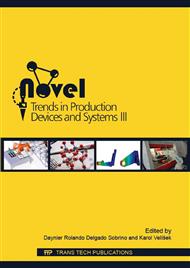[1]
L. Fen, Z. Shengqu, Z. Huamin, L. Jianhui, A Study on the Distinguishing Responses of Shrinkage and Warpage to Processing Conditions in Injection Molding, Journal of Applied Polymer Science. vol. 125, no. 1, (2011).
Google Scholar
[2]
P. Postawa, J. Koszkul, Change in injection moulded parts shrinkage and weight as a function of processing conditions, Journal of Materials Processing Technology. vol. 162, (2005).
DOI: 10.1016/j.jmatprotec.2005.02.241
Google Scholar
[3]
X.M. Cheng, L. Zhou, N.Y. Sheng, Y.D. Wu, Injection Molding and Warpage of Thin-walled Parts Based on Simulated Deformation. Computational Intelligence and Software Engineering, 2009. CiSE 2009. International Conference on, pp.1-4, (2009).
DOI: 10.1109/cise.2009.5362816
Google Scholar
[4]
H.S. Park, N.H. Pham, Design of Conformal Cooling Channels for an Automotive Part, International Journal of Automotive Technology. vol. 10, no. 1, (2009).
DOI: 10.1007/s12239-009-0011-7
Google Scholar
[5]
DSM Engineering Plastics. Design Guide - Performance and Value with Engineering Plastics, (2005). Information on www. dsmep. com.
Google Scholar
[6]
CH. Yuing, H. Shih Tsun, H. Sung-Wei, Ch. Shia-Chung, H. Chao-Tsai, Ch. Meng- Chih, Y. Venny, Warpage Managment Usung Three Dimensional Thickness Control Method in Injection Molding, CoreTech System (Moldex3D) Co., Ltd., Hsinchu, Taiwan Information on www. moldex3d. com/en/resources-library.
Google Scholar
[7]
G. Menges, W. Michaeli, P. Mohren, How to make injection molds, Hanser, Hanser garden, third edition, Ohio, Cincinnati, 2001. ISBN 3-446-21256-6.
DOI: 10.3139/9783446401808.fm
Google Scholar
[8]
K. Slye, J. Coulter, B. Bekisli, T. Skiba, The Effect of Melt Rotation Technology on Particle Distribution during Injection Molding. Lehigh University, Bethlehem, PA (2010).
Google Scholar
[9]
Ch. Ching-Chang, P. Yi-Hui, Y. Wen-Li, Ch. Rong-Yeu, Effect of Melt Rotation on Warpage Phenomena in Injection Molding. CoreTech System Co., Ltd., Hsinchu, Taiwan, Information on www. moldex3d. com/en/resources-library.
Google Scholar
[10]
R. Sánchez, J. Aisa, A. Martinez, D. Mercado. On the relationship between cooling setup and warpage in injection molding, Measurement. vol. 45, (2012) p.1051–1056, ISSN: 0263-2241, DOI: 10. 1016/j. measurement. 2012. 01. 039.
DOI: 10.1016/j.measurement.2012.01.039
Google Scholar
[11]
T. Lucyshyn, G. Knapp, M. Kipperer, C. Holzer, Determination of the Transition Temperature at Different Cooling Rates and Its Influence on Prediction of Shrinkage and Warpage in Injection Molding Simulation, Journal of Applied Polymer Science. vol. 123, no. 2, (2011).
DOI: 10.1002/app.34591
Google Scholar
[12]
E. Bociąga, T. Jaruga, K. Lubczyñska, A. Gnatowski, Warpage of injection moulded parts as the result of mould temperature difference. Archives of Materials Science and Engineering, vol. 44, no. 1, (2010).
Google Scholar
[13]
D. Kazmer, Injection mold design engineering, Hanser Verlag, p.423, 2007 ISBN 978-3-446-41266-8.
Google Scholar
[14]
M. Kurt, O. Saban Kamber, Y. Kaynak, Gu. an Atakok, O. Girit, Experimental investigation of plastic injection molding: Assessment of the effects of cavity pressure and mold temperature on the quality of the final products, Materials and Design. vol. 30, no. 8, (2009).
DOI: 10.1016/j.matdes.2009.01.004
Google Scholar
[15]
Ch. Xi, G. Furong, A study of packing profile on injection molded part quality, Materials Science and Engineering A358. (2003) pp.205-213, ISSN: 0921-5093, DOI: 10. 1016/S0921-5093(03)00290-9.
DOI: 10.1016/s0921-5093(03)00290-9
Google Scholar
[16]
Keehae Kwon, A.I. Isayev, K.H. Kim, C. van Sweden, Theoretical and Experimental Studies of Anisotropic Shrinkage in Injection Moldings of Semicrystalline Polymers, Polymer Engineering & Science. vol. 46, no. 6, (2006).
DOI: 10.1002/pen.20546
Google Scholar
[17]
S. Senthilvelan, R. Gnanamoorthy, Influence of reinforcement on composite gear metrology, Mechanism and Machine Theory, vol. 43, (2008) p.1198–1209, ISSN: 0094-114X DOI: 10. 1016/j. mechmachtheory. 2007. 09. 002.
DOI: 10.1016/j.mechmachtheory.2007.09.002
Google Scholar
[18]
R. Zheng, P. Kennedy, N. Phan-Thien, X-J. Fan, Thermoviscoelastic simulation of thermally and pressure-induced stresses in injection moulding for the prediction of shrinkage and warpage for fibre-reinforced thermoplastics, Journal od Non-Newtonian Fluid Mechanics. vol. 84, (1999).
DOI: 10.1016/s0377-0257(98)00148-7
Google Scholar
[19]
X. Chena, Y.C. Lama, D.Q. Lib, Analysis of thermal residual stress in plastic injection molding, Journal of Materials Processing Technology. vol. 101, no 1–3, (2000) p.275–280. DOI: 10. 1016/S0924-0136(00)00472-6.
DOI: 10.1016/s0924-0136(00)00472-6
Google Scholar
[20]
W. Tong-Hong, Y. Wen-Bin, Study on residual stresses of thin-walled injection molding, European Polymer Journal. vol. 41, (2005) p.2511–2517, ISSN: 0014-3057, DOI: 10. 1016/j. eurpolymj. 2005. 04. 019.
DOI: 10.1016/j.eurpolymj.2005.04.019
Google Scholar
[21]
J. Avery, Gas-Assist Injection Molding - Principles and Applications. Hanser Gardner Publications, Inc., Ohio, Cinncinati, 203 pages, 2001. ISBN: 9781569902981.
Google Scholar
[22]
P. Dier, R. Goralski, Gas Assist Injection Molding. Bauer Compressors, Inc., (2000).
Google Scholar
[23]
T. Stachowiak, T. Jaruga, Structure of gas-assisted injection moulded parts, Journal of Achievements in Materials and Manuacturing Engineering. vol. 38, no. 2, (2010) pp.139-145, ISSN 1734-8412.
Google Scholar
[24]
Z. Guo-Qiang, Y. Wei, H. Li, Y. Ming-Bo, L. Wei, L. Chuan-Tai, Flow-induced Fiber Orientation in Gas-assisted Injection Molded Part, Materials Letters. vol. 61, no. 16, (2007) p.3436–3439, ISSN 3436-3439, DOI: 10. 1016/j. matlet. 2006. 11. 085.
DOI: 10.1016/j.matlet.2006.11.085
Google Scholar
[25]
Z. Guo-Qiang, H. Li., Y. Wei, Y. Bin, Y. Ming-Bo, L. Qian, Hierarchical Crystalline Structure of HDPE Molded by Gas-assisted Injection Molding, Polymer. vol. 48, no. 19, (2007).
DOI: 10.1016/j.polymer.2007.05.047
Google Scholar
[26]
H. Li, Y. Wei, Y. Bin, Y. Mingbo, Z. Guoqiang, A. Haining, Banded Spherulites of HDPE Molded by Gas-assisted and Conventional Injection Molding, Polymer. vol. 49, no. 19, (2008).
DOI: 10.1016/j.polymer.2008.07.005
Google Scholar
[27]
Shia-Chung. Ch., Yuan. K., Hsien-Yang. Yeh., Effect of Gas Channel Design on Bending Properties of Gas-Assisted Injection Molded Polystyrene Parts, Journal of Reinforced Plastics and Composites. vol. 17, no. 13, (1998).
DOI: 10.1177/073168449801701306
Google Scholar
[28]
Ch. Rean Der, C. Shia-Chung, J. Ming Chang, Y. Hwei-Yen., Mechanical properties of gas-assisted injection moulded PS, PP and Nylon parts, Polymer. vol. 40, no. 11, (1999) p.2949–2959, ISSN 0032-3861, DOI: 10. 1016/S0032-3861(98)00525-4.
DOI: 10.1016/s0032-3861(98)00525-4
Google Scholar
[29]
Ch. Shia-Chung, H. Song-Wei, Ch. Cheng-Yi, H. Hsin-Wei, Y. Wen-Hsien, Simulation and Verification of Part Surface Quality using External Gas-assisted Injection Molding Process. Chung Yuan Christian University, Taiwan; CoreTech System Co.
Google Scholar
[30]
S.F. Jiang, J.B. Zhang, G.Z. Chai, J.Q. Li, M.Y. Su, Cooling Simulation of External Gas-Assisted Injection Molding, Applied Mechanics and Materials. vol. 44-47, (2011).
DOI: 10.4028/www.scientific.net/amm.44-47.1607
Google Scholar


